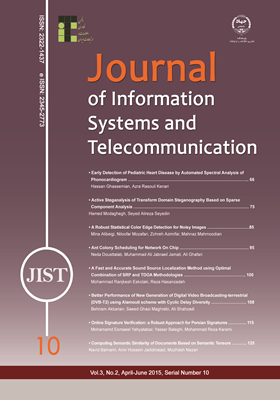Early Detection of Pediatric Heart Disease by Automated Spectral Analysis of Phonocardiogram
محورهای موضوعی : Signal Processing
1 - Tarbiat Modares
کلید واژه: Phonocardiogram (PCG), Murmur, Cardiac, k-nn classifier, pediatric, wavelet, , ,
چکیده مقاله :
Early recognition of heart disease is an important goal in pediatrics. Developing countries have a large population of children living with undiagnosed heart murmurs. As a result of an accompanying skills shortage, most of these children will not get the necessary treatment. Taking into account that heart auscultation remains the dominant method for heart examination in the small health centers of the rural areas and generally in primary healthcare setups, the enhancement of this technique would aid significantly in the diagnosis of heart diseases. The detection of murmurs from phonocardiographic recordings is an interesting problem that has been addressed before using a wide variety of techniques. We designed a system for automatically detecting systolic murmurs due to a variety of conditions. This could enable health care providers in developing countries with tools to screen large amounts of children without the need for expensive equipment or specialist skills. For this purpose an algorithm was designed and tested to detect heart murmurs in digitally recorded signals. Cardiac auscultatory examinations of 93 children were recorded, digitized, and stored along with corresponding echocardiographic diagnoses, and automated spectral analysis using discrete wavelet transforms was performed. Patients without heart disease and either no murmur or an innocent murmur (n = 40) were compared to patients with a variety of cardiac diagnoses and a pathologic systolic murmur present (n = 53). A specificity of 100% and a sensitivity of 90.57% were achieved using signal processing techniques and a k-nn as classifier.
Early recognition of heart disease is an important goal in pediatrics. Developing countries have a large population of children living with undiagnosed heart murmurs. As a result of an accompanying skills shortage, most of these children will not get the necessary treatment. Taking into account that heart auscultation remains the dominant method for heart examination in the small health centers of the rural areas and generally in primary healthcare setups, the enhancement of this technique would aid significantly in the diagnosis of heart diseases. The detection of murmurs from phonocardiographic recordings is an interesting problem that has been addressed before using a wide variety of techniques. We designed a system for automatically detecting systolic murmurs due to a variety of conditions. This could enable health care providers in developing countries with tools to screen large amounts of children without the need for expensive equipment or specialist skills. For this purpose an algorithm was designed and tested to detect heart murmurs in digitally recorded signals. Cardiac auscultatory examinations of 93 children were recorded, digitized, and stored along with corresponding echocardiographic diagnoses, and automated spectral analysis using discrete wavelet transforms was performed. Patients without heart disease and either no murmur or an innocent murmur (n = 40) were compared to patients with a variety of cardiac diagnoses and a pathologic systolic murmur present (n = 53). A specificity of 100% and a sensitivity of 90.57% were achieved using signal processing techniques and a k-nn as classifier.


